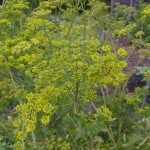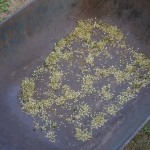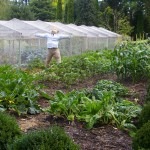I love parsnips — great roasted, great in soups, and great when they’re fried like chips!
I have been growing parsnips in the Southern Highlands of New South Wales for a number of years, mainly the Hollow Crown variety. The climate is good for growing such European root crops because of the cool nights in spring and autumn and frosts during winter—perfect for biennial crops such as parsnips carrots and beetroots.
I sow seeds in early spring (September) and harvest through the following autumn and winter. We are blessed with basalt soil, but I always add a sprinkle of lime, general fertiliser, and poultry-based pellet fertiliser. I don’t as a rule add any cow or sheep manure. The seeds go in one cm deep drills and I thickly mulch each side of the row with only a light dusting over the row itself. The idea is to prevent evaporation thereby cutting down on the need to water. Seeds take about three weeks to germinate and therein lies a problem—parsnips have a poor germination rate. You can fill in the gaps with replacement seed, but my solution is to save my own seed.
 I let three or four parsnips run to seed in spring. When the seed heads are mature, I strip off the seeds, dry them, then put them in a freezer for 5 minutes to kill any bugs. I use paper bags for long-term storage. My experience is that there will be a good germination rate for about two years.
I let three or four parsnips run to seed in spring. When the seed heads are mature, I strip off the seeds, dry them, then put them in a freezer for 5 minutes to kill any bugs. I use paper bags for long-term storage. My experience is that there will be a good germination rate for about two years.
I don’t save the seeds of other root crops such as carrots and beetroots because they all tend to get eaten, and germination is not such a problem.  I did once try saving the seeds from the Western red carrots which had bolted. Silly me! Firstly, Western reds appear prone to bolt in my growing conditions; and secondly, by taking seeds from bolted carrots, I was selecting the bolting characteristic. I should have let the few plants that hadn’t bolted grow through to the next year, then collect their seeds. But why bother when the other carrots varieties grow well in our garden?
I did once try saving the seeds from the Western red carrots which had bolted. Silly me! Firstly, Western reds appear prone to bolt in my growing conditions; and secondly, by taking seeds from bolted carrots, I was selecting the bolting characteristic. I should have let the few plants that hadn’t bolted grow through to the next year, then collect their seeds. But why bother when the other carrots varieties grow well in our garden?
Once established, parsnips don’t need a lot of water because of their deep root system. Because the tops become quite large it is best to have rows at least 30 cm away from other crops. I’ve now started positioning the rows in an E-W alignment.
Previously, I’d grown rows in a N-S alignment but have noticed other rows have been shaded especially in the afternoon when the sun is low. The height of the parsnip tops means that the afternoon Westerly sun shades other N-S aligned plant rows which are planted to the East of the parsnips.
(One year I grew some black salsify in a N-S alignment to the East of a N-S aligned parsnip row. The black salsify grew well but rotted off—a combination perhaps of the watering regime and shade from the parsnips.)
Conventionally rows are aligned N-S, but I suspect this arises from northern European gardening when the sun is always lower in the sky. My garden is in Bowral NSW and gets full sun, but is somewhat protected from the East. Because of the lower latitude, the sun is high in the middle of the day so I don’t believe the row alignment matters. In the afternoon, however, the sun is lower and shading becomes a factor.
The southern parts of Australia, eg Melbourne, Adelaide, Tasmania, of course, are at higher latitudes so the sun will be lower and therefore the conventional wisdom might hold. (I think my ideas about row orientation are worthy of discussion and scientific testing—I am happy to be corrected on this issue by readers of this article.)
Parsnips grow more slowly than carrots and beetroot and I begin to harvest them in March (carrots and beetroot start to be harvested by January). The roots are fine when kept in the ground and used when needed. The problem, however, is that they can start to rot around the tops, especially the large roots, towards the end of winter. Culprits appear to be slugs and snails so they should be deterred—and it’s probably a good idea to prevent water collecting in the area. (Anyway, with large roots it is quite feasible to remove the rotted area without affecting the flavour of the vegetable that remains.)
Parsnip plants will die down and lose their leaves over winter and put on new growth in spring. It’s a matter of judgement when you stop harvesting—the plants will certainly have a woody core once they start to throw up a flower stalk in late spring. Such cores can be removed because the outer part of the root is still edible.
I find parsnips store well in the fridge so you don’t have to use all of a particularly large root or throw unused bits away. They do have a limited life in the fridge, however, so they tend to graduate from the fridge to the freezer. The roots are peeled, cut into chunks and frozen. When it comes to soup time, they are thawed out, cooked, and mashed—the freezing process helps to soften them (the same is true for frozen pumpkins) so baking them is not an option.
A shortened version of this article appeared on John Carter’s vegetable gardening Facebook page.
 Although John Carter started vegetable gardening in South-West England, his other horticultural love is growing Australian native plants and he has been a member of the Australian Native Plant Society Canberra Region since the early 1980s. Since 1987 John has operated as a hobby The Plant People, a private native plant nursery based in Canberra.
Although John Carter started vegetable gardening in South-West England, his other horticultural love is growing Australian native plants and he has been a member of the Australian Native Plant Society Canberra Region since the early 1980s. Since 1987 John has operated as a hobby The Plant People, a private native plant nursery based in Canberra.
Related Articles:
Tomato Brown Rugose Fruit Virus (ToBRFV)
Tomato Brown Rugose Fruit Virus (ToBRFV) is a plant virus that causes severe crop losses (up to 75%) in tomatoes, but also in peppers (capsicums and…
Garden Journaling – Slow down to tune in.
As we move through the year and our gardens evolve, there's something magical about documenting the journey. Garden journaling is an art that enables…


